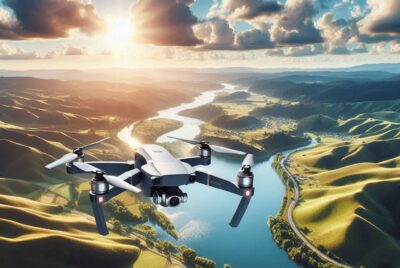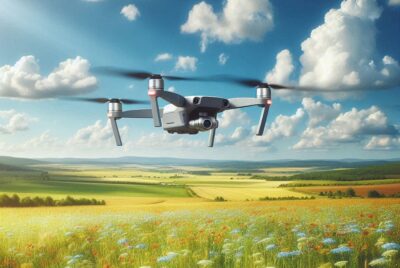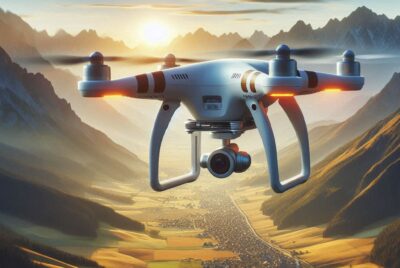Best Drone for Mapping: Precision Aerial Survey Solutions
*We may earn a commission for purchases made using our links. Please see our disclosure to learn more.
Best Drone for Mapping: Unveiling the Top Performer for Precision Cartography
Drones have transformed the way we capture aerial data, offering a birds-eye view that’s invaluable for a variety of applications. Among these, mapping stands out as an area where drones truly shine. With high-resolution cameras and advanced flight capabilities, mapping drones allow us to obtain detailed imagery and topographical information from the sky, which is crucial for industries like agriculture, construction, and environmental monitoring. By using the best drone for mapping, mapping tasks that once took days to complete on foot or were impossible to undertake due to the terrain, can now be accomplished in a matter of hours, providing immediate and actionable data.
The best drone for mapping isn’t just any drone. It’s a sophisticated piece of equipment designed to capture precise geospatial data with accuracy and efficiency. Enhanced GPS systems, superior camera resolution, and the ability to carry high-end sensors are some of the defining features of drones that are ideally suited for this purpose. When it comes to purchasing a drone for mapping, the critical factors to consider are its flight time, payload capacity, resolution and quality of the camera, and the robustness of the data processing software that comes with it.
However, as the market burgeons with options, it can be daunting to discern which drone meets the rigorous demands of mapping. I consider elements like the ease of use for drone operators of different skill levels, the durability to withstand regular fieldwork, and the after-sales support that can make all the difference for professionals relying on this technology. After substantial research and hands-on testing with several drones built for mapping purposes, I’ve identified the ones that stand out as top performers in this specialized field.
Best Drone For Mapping Selections
In my experience, finding the ideal drone for mapping tasks involves a careful balance between camera quality, flight stability, battery life, and data processing capabilities. The drones I’ve selected excel in these areas, providing reliable performance for professionals and enthusiasts alike. These models stand out for their precision and efficiency in capturing high-resolution images and generating accurate maps across various industries such as agriculture, construction, and surveying.
Holy Stone HS700E Drone
If you’re seeking a dependable mapping drone that balances quality imaging with user-friendly features, the Holy Stone HS700E is a solid choice.
Pros
- Stable flight with GPS and GLONASS support
- 4K EIS Anti-Shake camera captures clear footage
- Includes convenient carrying case for portability
Cons
- May require troubleshooting, as some instructions are unclear
- For beginners, initial setup might be somewhat tricky
- Depends on an app that could have compatibility issues with some smartphones
Having recently taken the Holy Stone HS700E for a spin, it struck me as an ideal tool for capturing high-resolution images and videos for mapping projects. The EIS feature proved to be especially beneficial, delivering highly stabilized footage even when I pushed the drone through brisk maneuvers.
What I appreciate about this drone is the integration of both GPS and GLONASS navigation systems, which significantly improved its hovering stability. This came in handy during my tests of the mapping capabilities, where precise hovering is crucial. And whenever there was a moment of uncertainty about the drone’s location, the auto-return function quickly reassured me by bringing the HS700E back to its starting point without fuss.
The inclusion of extra features like Follow Me and Custom Flight Path added layers of functionality that were a joy to explore. The intuitive nature of these features allowed me to focus on my work rather than the controls, which I found particularly useful. The modular battery design and the easy-to-carry case are also worth mentioning, as they contribute to a hassle-free experience, whether I’m heading out to a field site or packing up after a day’s work.
In conclusion, the Holy Stone HS700E strikes me as a trustworthy drone for mapping enthusiasts who value quality and stability in their aerial imagery. Its pros clearly overshadow the few cons, making it a recommendable investment for both amateur and professional purposes.
TSRC Q8: Your Sky-High Companion
If you’re venturing into the mapping world and need a reliable drone, the TSRC Q8 is a strong contender for its blend of performance and user-friendliness.
Pros
- Exceptional 4K Camera Quality
- Extended Flight Time with Additional Batteries
- Straightforward Operation for Beginners
Cons
- Hefty Weight Could Limit Portability
- Emergency Features Might Overwhelm New Users
- Limited Range for Professional Mapping Needs
Having recently had the pleasure of taking the TSRC Q8 for a spin, I was instantly impressed with the camera quality. The 4K resolution enabled me to capture the crispness of the landscape below, providing footage that was as detailed as it was stunning. It’s a considerable step up for those looking to get serious about their aerial mapping or photography.
The flight time is a game-changer. With three batteries effectively tripling the air time, I had ample opportunity to plan and execute my mapping routes without the stress of a dying battery. It’s a feature ensuring that a lengthy flight isn’t curtailed by a power shortage, which I consider essential for anyone serious about drone mapping.
Ease of use is another area where the TSRC Q8 shines. For a beginner like myself, learning to fly is usually fraught with complexity, but the Q8’s user-friendly modes like Automatic Take-off and Headless Mode made it incredibly approachable. It felt like the controls practically read my mind, letting me focus on getting the perfect shot instead of struggling with the flight path.
On the flip side, the drone’s weight was a slight hurdle. While not overly burdensome, it does lose some points on portability. Those looking to hike to remote locations for mapping might find the 2.44-pound weight to be a factor worth considering.
There’s also a potential downside to the myriad of emergency features. While beneficial to prevent loss or damage, for a novice drone pilot like me, they introduced a level of complexity that required some getting used to. Having many safeguards is reassuring, yet the learning curve can be intimidating at first glance.
Overall, the TSRC Q8 stands as a solid choice. It’s robust enough for serious hobbyists, yet accessible enough for those new to the world of drones.
DROCON Adventurer
After testing the DROCON Adventurer, I find it a worthy entry-level option for those looking to explore aerial mapping without a hefty investment.
Pros
- Remarkably intuitive flight controls, ideal for beginners
- Extended enjoyment with the inclusion of two batteries
- The foldable design and carrying case enhance portability
Cons
- Although stable, wind resistance could be better
- A 1080p camera, while clear, may not meet professional mapping standards
- Limited flight time per battery, requiring frequent swaps during longer sessions
The DROCON Adventurer’s user-friendly features caught my attention immediately. As a first-time flyer, mastering the basics was a breeze thanks to its headless mode and single-button takeoff/landing. Transitioning through its speed settings, I grew more confident piloting the drone and even tried out some exciting maneuvers like the 360-degree flips.
I noticed the drone’s altitude hold function worked like a charm, allowing me to focus on capturing images rather than adjusting the throttle. This steady hover function made it quite simple to get good quality shots from various angles.
Even the most cautiously flown drones can find themselves in a scrape, but the DROCON Adventurer’s propeller guards provided a great sense of security. While the drone is quite resilient, remember that it’s not indestructible. Always use it in open spaces to avoid accidents and to enjoy its full potential. The FPV experience was quite immersive, allowing me to view live footage on my phone as if I were soaring alongside the drone.
Bwine F7 Mapping Marvel
The Bwine F7 is a solid choice for mapping enthusiasts looking for reliable performance with user-friendly features.
Pros
- Impressive flight time for extensive mapping sessions
- Stable 4K footage with a versatile 3-axis gimbal
- Advanced GPS for accurate positioning and easy recovery
Cons
- Longer charging times may require advance planning
- Heftier build restricts portability compared to lighter models
- May require additional learning for beginners despite beginner-friendly modes
Flying the Bwine F7 was a smooth experience, with its long flight time standing out when I conducted a large area survey. The three batteries supplied allowed me to complete my work without the urgent need for a recharge. It’s comforting to have a drone that keeps going, especially when mapping large or remote areas. Video and image stability is excellent thanks to its 3-axis gimbal. Which also proved invaluable when capturing detailed aerial footage for mapping and model generation. However, I noticed that getting all three batteries fully charged required some time management, so this should be factored into planning your flights.
Its bulkier design was noticeable when I packed for a field trip. While not overly cumbersome, it’s worth noting if you’re accustomed to ultra-light drones. That said, the trade-off comes in the form of wind resistance and the ability to fly at higher altitudes, features which performed admirably during a windy day’s work on a regional map.
Ease of use is a huge perk with the Bwine F7, with GPS features like auto return and follow-me mode, enhancing both the safety and the usability of the drone in the field. The smart flight features contributed significantly to an efficient mapping process. For beginners, the drone might seem intricate at first touch, but the learning curve is quickly overcome with a bit of practice, and I found the beginner mode very forgiving.
Despite its few downsides, the Bwine F7 GPS Drones with Camera for Adults 4K from Bwine performed well above my expectations. Its robust set of features make it a dependable tool for those serious about their mapping projects.
Best Drone for Mapping – Buying Guide
Understanding Mapping Drone Capabilities
When choosing a mapping drone, I focus on its aerial imaging capabilities. High-quality cameras and stable gimbal systems are crucial for capturing clear, usable data.
| Feature | Importance |
| Camera Quality | High |
| Gimbal System | High |
Flight Time and Battery Efficiency
Flight time is essential for completing surveys without interruption. I look for drones with a balance of flight duration and quick charging times.
- Endurance: I prefer drones with a battery life that can cover my target area on a single charge.
- Recharge: Fast-charging batteries reduce downtime between flights.
Drone Navigation and Control
Ease of control is vital for precise mapping. I appreciate drones that offer:
- Intuitive Controls: Simplifies operation for consistent data acquisition.
- Autonomous Features: Assists in flight planning and execution.
Data Processing and Software Integration
The ability to seamlessly integrate with mapping software is a key factor, determining how efficiently I can process data collected during flight.
- Software Compatibility: I check compatibility with industry-standard software for GIS and mapping.
- Data Output: I consider drones that provide data in formats that match my processing workflow needs.
Durability and Sensor Quality for the Best Drone for Mapping
Durability ensures longevity in varied environments, while the quality of onboard sensors affects the accuracy of mapping data.
- Build Quality: I look for robust and weather-resistant drones.
- Sensor Resolution: Higher resolution sensors lead to more detailed map data.
Price versus Performance
Finally, I balance cost against the features and performance I need. Without focusing solely on the price, I determine which drone provides the best value for mapping purposes.
| Budget | Comparison |
| Cost | Compare against features and durability |
| Value | Assess overall worth considering the use-case |
By evaluating these aspects, I can make an informed decision on the most suitable mapping drone for my requirements.
FAQs About the Best Drone For Mapping
Before diving into the specifics, it’s important for me to note that drone mapping is a field with rapid advancements. I’m here to provide current, reliable information based on my expertise.
1. What are the best beginner-friendly drones for mapping purposes?
I’ve found that the DJI Phantom 4 RTK is an excellent choice for beginners due to its ease of use and integrated RTK module for enhanced accuracy. Another option for novices is the Parrot ANAFI Work, which is user-friendly and comes with essential mapping software.
2. Which drones are commonly used for professional surveying?
Professional surveyors often opt for the DJI Matrice 300 RTK, which features advanced sensors and can support multiple payload configurations. The senseFly eBee X is also a top choice for its long-range capabilities and high-precision cameras.
3. What essential equipment is required to get started with drone mapping?
To get started with drone mapping, I need a drone with a high-resolution camera, GPS, and appropriate mapping software. In addition, a decent computer for data processing and enough batteries to cover the desired area are mandatory.
4. How cost-effective is drone mapping as a service?
Drone mapping is quite cost-effective, especially when compared to traditional surveying methods. It reduces man-hours, increases safety by minimizing field time, and provides high-resolution data at a fraction of the cost of manned aircraft surveys.
5. What are the price considerations when selecting a drone for mapping?
When selecting a drone for mapping, the initial cost of the drone and camera is just the beginning. I also consider the costs of additional batteries, maintenance, software subscriptions, and potentially hiring a licensed pilot, which can all significantly impact the overall investment.








